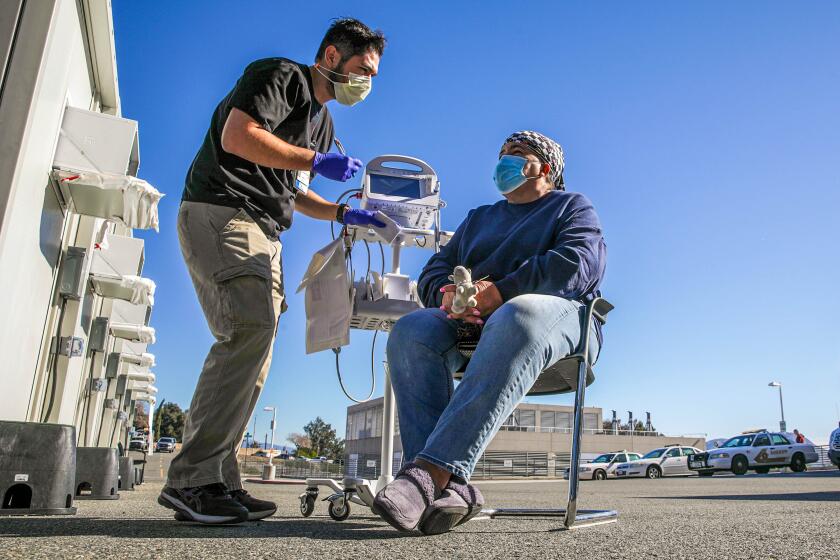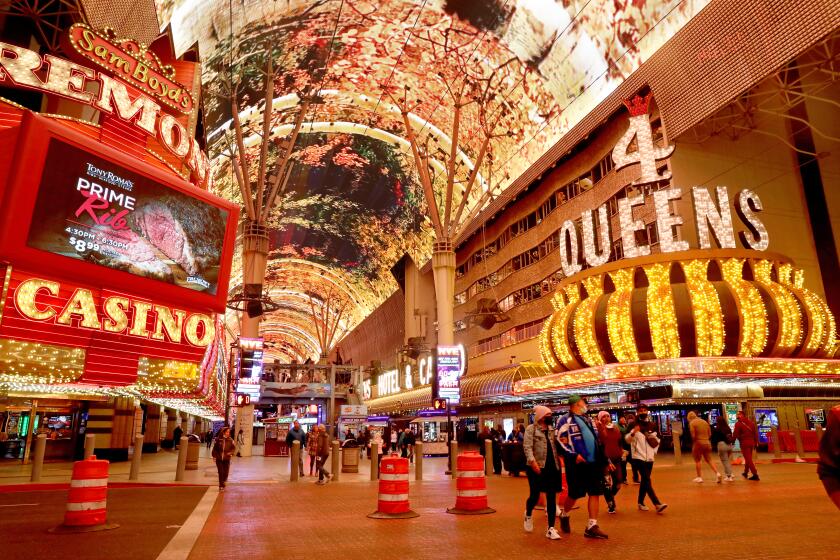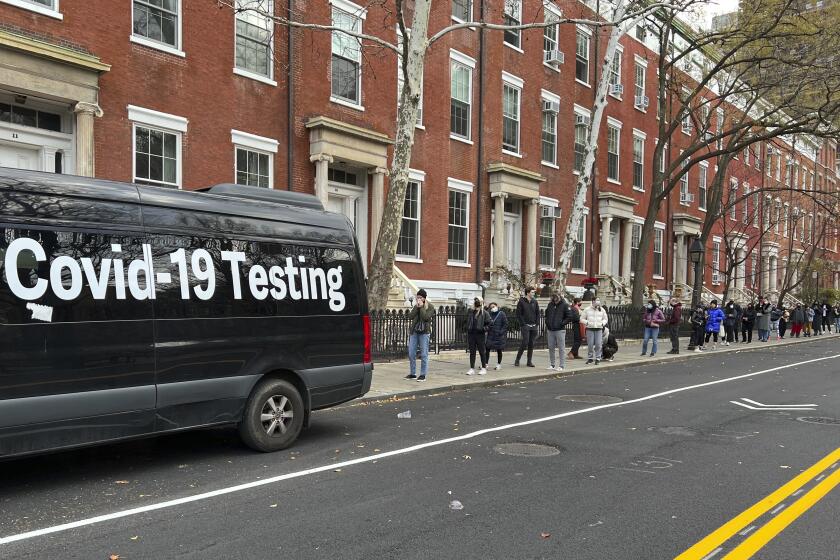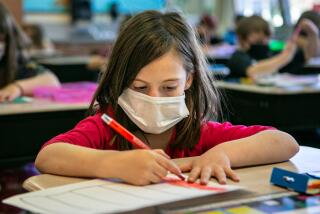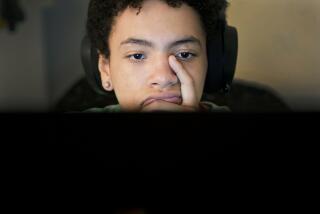Anxious. Helpless. Upset. Omicron surge leaves U.S. parents, teachers and students on edge
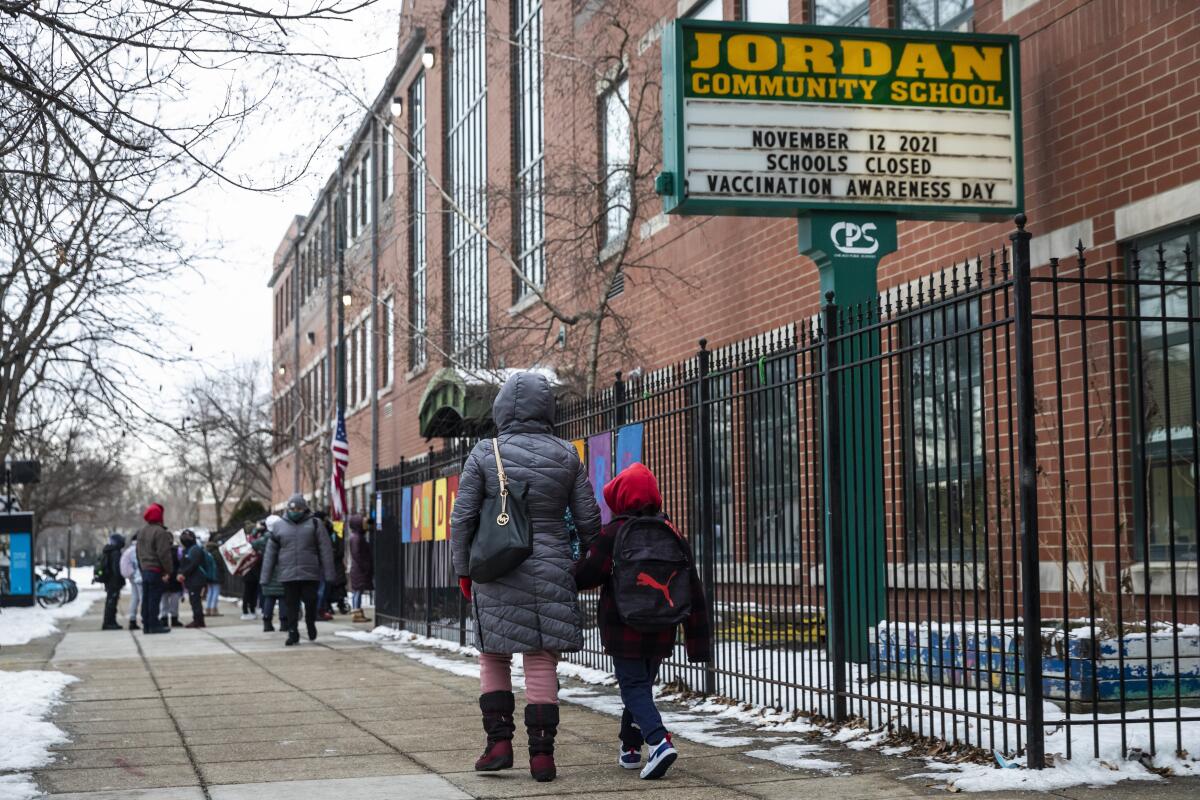
- Share via
Tierra Pearson suspected the winter months would mean a sharp surge in coronavirus cases. So the Chicago mother made sure she and her two sons — seventh- and 10th-graders — were fully vaccinated.
“We were going to be prepared,” she recalled.
But as she kept the TV news on around the clock over much of the last two weeks, watching in dismay as leaders of the Chicago Teachers Union and Mayor Lori Lightfoot battled over safety precautions and schools reopening, Pearson felt far from prepared. She felt helpless.
“We as parents were totally left out of the conversation,” she said. “We had no voice about our schools, and that was truly a shame.”
As the Omicron variant continues to propel a massive surge in infections that has hit many educators and school staff, parents across the nation are faced with painful deja vu: toggling between virtual and in-person schooling and trying to keep up with constantly evolving district policies.
This week the Biden administration announced that it is planning to make 10 million COVID-19 test kits available each month for schools as part of its push to keep classrooms open during this wave of infections — a critical step considering that vaccination rates are lower among children.
After two years, hospitals thought they had a handle on treating COVID-19. But Omicron has hit them harder than ever.
Overall, 63% of Americans are fully vaccinated, but among children ages 12 to 17 the rate sits at 54% and among those 5 to 11, the rate drops to 17%. (In Vermont, 48% of that age group are vaccinated; in California, nearly 19%; and in Mississippi, 5%.)
But disruptions have occurred and at regular intervals.
On average, about 4% of schools across the country — 4,179 of 98,000 schools — dealt with COVID-19 disruptions such as closures this week, according to Burbio, a K-12 school opening tracker. That’s down slightly from 5,376 schools last week and a fraction of the peak that occurred around Labor Day 2020 when more than 60% of schools were closed, said Dennis Roche, Burbio’s co-founder.
Most of the closures were in the Northeast and Midwest, but some schools were starting to close in the West and South, Roche said. In Minneapolis, schools will go virtual for two weeks starting Friday because of a surge in Omicron cases among teachers. In Louisville, Ky., Jefferson County Public Schools shifted to remote learning because of COVID staffing shortages, while in the Portland, Ore., metro area, school districts moved to remote learning due to surges in cases and teachers being out sick.
Across the U.S., students are threatening boycotts and walkouts. The Oakland Unified School District faces such a strike unless it addresses a list of pandemic health and safety concerns. Students want the district to return to remote learning unless it provides KN95 masks for all kids and are calling for increased testing, among other demands. On Jan. 7, 12 district schools were forced to close after teachers staged a “sickout,” citing COVID worries. About 500 teachers were reported absent. And in New York, hundreds of students in recent days boycotted classes and staged walkouts over concerns about testing and called for remote learning to be implemented.
“We’re really in a pressure cooker situation right now, because American families are holding up the economy, we’re holding up the healthcare system and then we’re also expected to hold up the public education system,” said Keri Rodrigues, president of the National Parents Union, a network of grass-roots parent groups. “A lot of families across this country are absolutely at their breaking point.”
Sports betting is on the rise in recent years. So are calls to gambling help hotlines. Then there’s the pandemic: ‘People are alone and struggling’
For many parents who live paycheck to paycheck, taking a few days off when schools close can mean the difference between having groceries or not and making rent or not, Rodrigues said. Beyond the financial loss, many parents worried that their kids’ mental health and grades would deteriorate when schools switch to remote learning.
“When you close down schools over an abundance of caution, understand what you are asking of American families who are already at the brink,” she said.
This week the Clark County School District, which spans Las Vegas and is the nation’s fifth largest school system with more than 320,000 students, announced it was canceling classes for two days due to extreme staffing shortages.
Jessica Atlas, a 46-year-old single mother, was already frustrated with the school district for not planning activities for her son, Ashton, 9, while he quarantined this week after he caught the flu and she tested positive for the coronavirus.
“I feel like the bottom’s falling out,” Atlas said, noting that Ashton had not been sent home with any additional schoolwork.
“There should be a plan in place if you send kids home. But there’s no organization, no real leadership and no real plan to catch these babies failing all over the place.”
The district said there would be no remote learning on the canceled school days.
“I’m on the edge of my seat just waiting with anxiety,” she said. “Are we going backwards? Are we going to be shut down completely?”
In Atlanta, six metro school districts began classes online after winter break because of high COVID-19 case counts. But by Monday, all but one reopened to offer in-person classes — even as they continued to battle high case rates and staff shortages.
“One of the most consequential takeaways over the past 22 months is that there is no doubt our young people need the positive influences and safe spaces our employees and school campuses provide more than ever,“ Mary Elizabeth Davis, superintendent of Henry County Schools south of Atlanta, wrote in a column for the Atlanta Journal-Constitution. “Pandemic or no pandemic, our belief in the power of in-person learning will remain strong, and we will continue to do everything we can to provide that wholesome experience for the success of our youth….”
Still, many students across the Atlanta area remained out of school.
Even as Atlanta Public Schools resumed in-person classes, Maria Arias, 46, a mother with two children in high school and two in day care, kept her kids home because her family had contracted COVID-19 over the winter break.
Exactly one year after the U.S. kicked off its vaccination campaign against COVID-19, cases are surging once again as the country cobbles together a response.
A grass-roots member of the Latino Assn. for Parents of Public Schools, Arias couldn’t go back to work as a server at a small ice cream parlor until her youngest children tested negative and could return to day care. “It’s just hard,” Arias said as she struggled to keep her older kids on task with their schoolwork.
In recent months, the issue of schools opening or closing has become a battle between politicians and unions.
Last week, President Biden said “we have no reason to think at this point that Omicron is worse for children than previous variants.”
“We know that our kids can be safe when in school, by the way. That’s why I believe schools should remain open. They have what they need,” he added.
Meanwhile, New York City Mayor Eric Adams, who took office this month, stood firm on plans to reopen schools in the new year. But in recent days, as cases in the city rise sharply, Adams has considered a virtual learning plan, but it has not been implemented.
Back in Chicago, the school district reopened this week after a two-week standoff between Lightfoot and the Chicago Teachers Union.
The union wanted the option to revert to remote instruction across the 350,000-student district, and without it, hundreds of teachers refused to teach in person for the last two weeks.
Still, Chicago leaders, including Lightfoot, rejected districtwide remote learning, saying that it’s detrimental to students and that schools are safe.
After several days of back-and-forth negations, both sides reached an agreement that included provisions for additional testing and metrics allowing for schools with major virus outbreaks to close and go virtual.
Natalie Neris, chief of community engagement at Kids First Chicago, a group that advocates for more resources for students, said the interests of families must be at the forefront of debates.
“Parents are the consistent stakeholder,” she said. “Everyone would benefit from recognizing their importance, listening to them more intently, and putting kids first daily.”
For Pearson, 32, a hybrid option provides a sense of ease. Last week, she began feeling sick and got tested along with her kids. Each of their results came back negative, except for her son who is in seventh grade, who tested positive. He had no symptoms. She kept him home from school this week.
“It’s all over the place with this virus, and things are changing daily,” she said. “Schools need to adjust and be flexible as well.”
Lee reported from Los Angeles and Jarvie from Atlanta.
More to Read
Sign up for Essential California
The most important California stories and recommendations in your inbox every morning.
You may occasionally receive promotional content from the Los Angeles Times.
